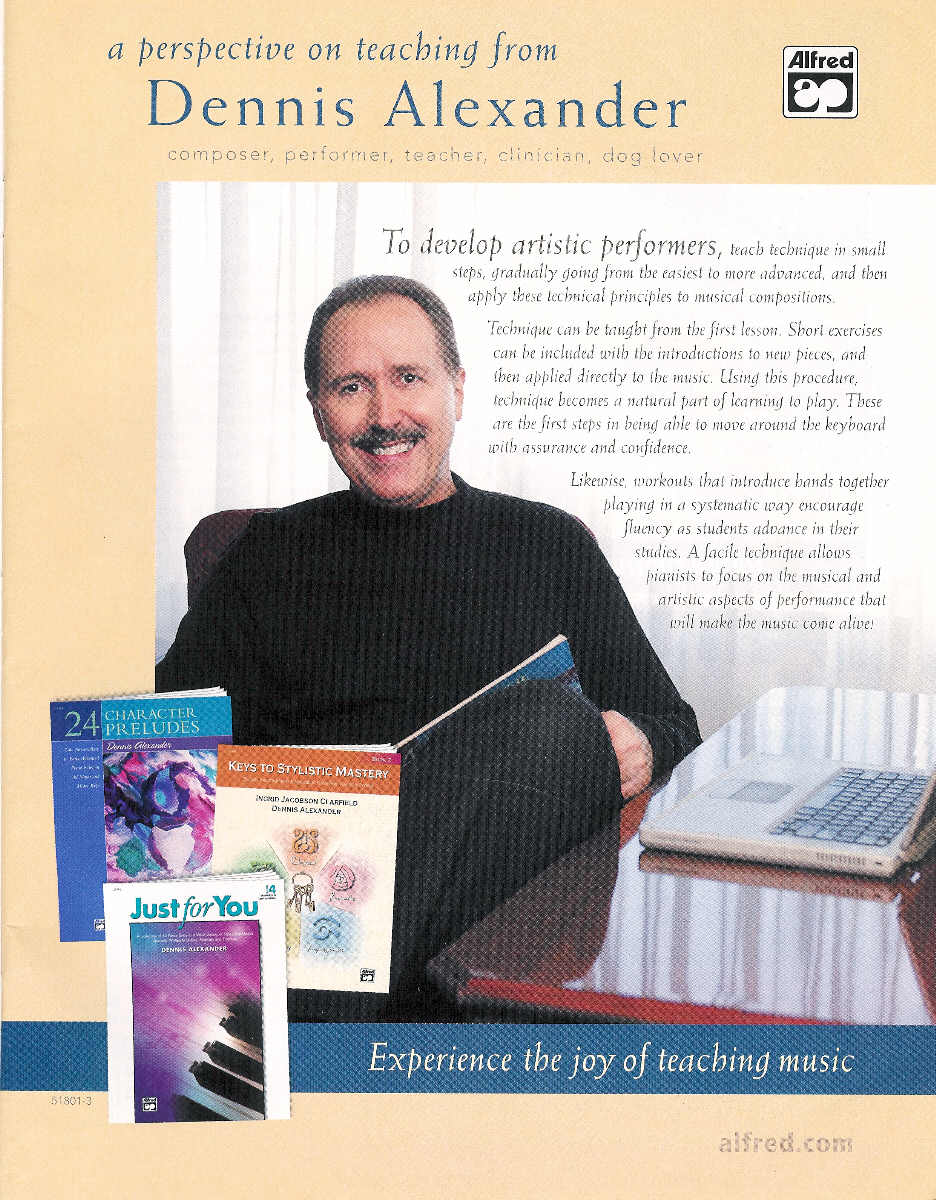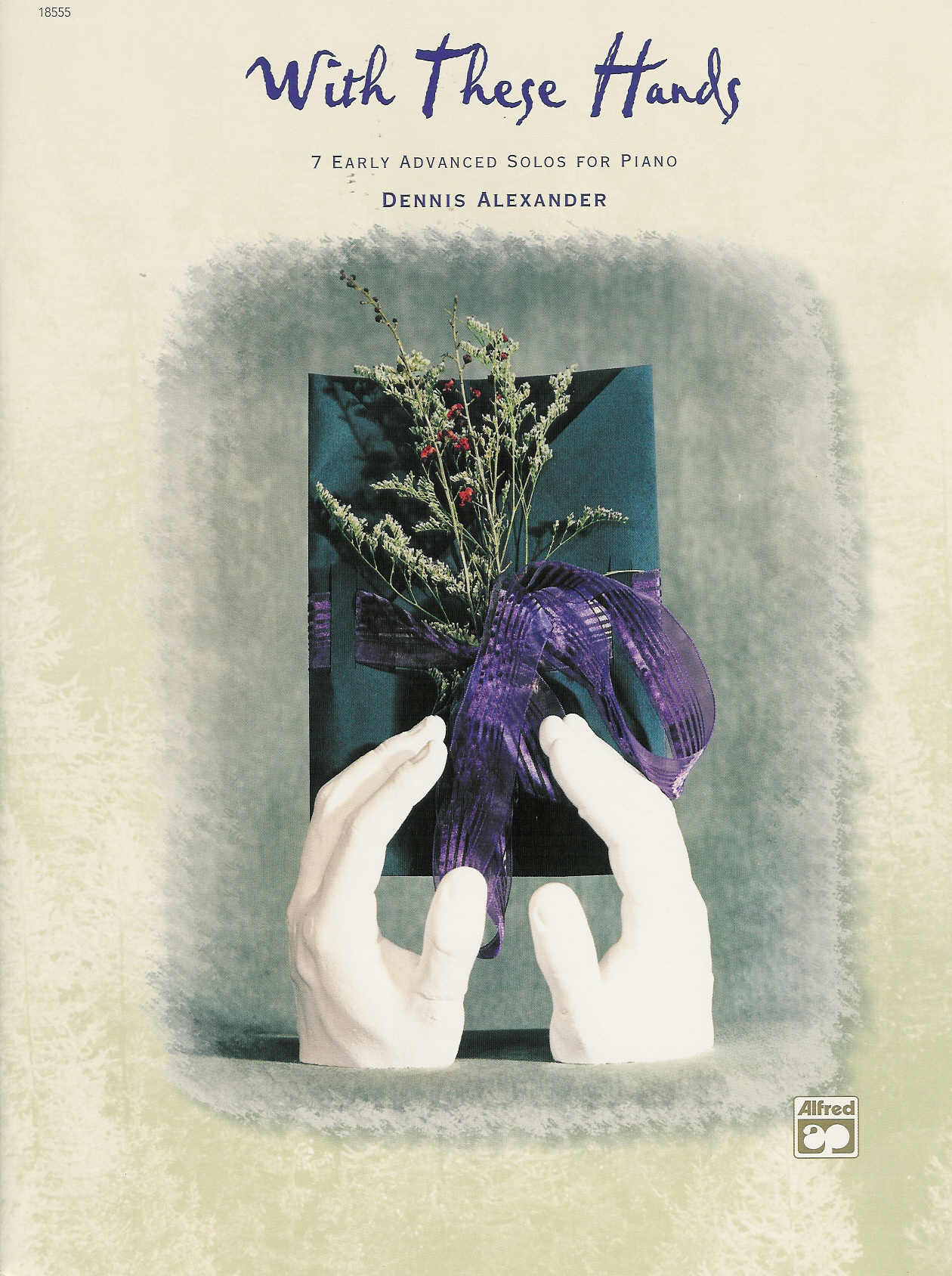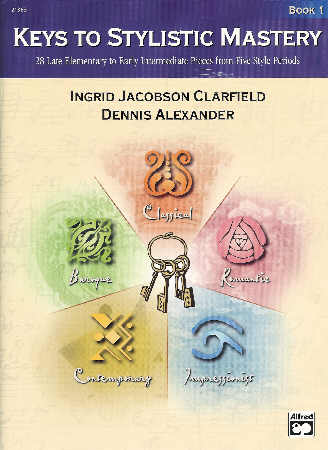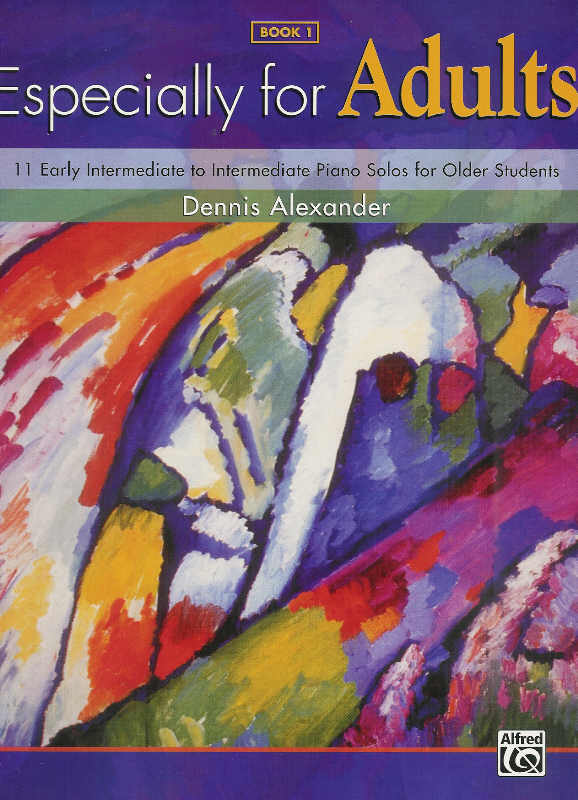A Composer Speaks

A few years ago, Schmitt Music Company in Minneapolis, MN asked me to contribute to their "Schmitt Music Piano Insider Magazine". I was asked to provide answers to a number of questions about my growing up years, how I became a composer, my greatest challenge as a teacher, and other interesting topics. So, instead of doing a teaching piece this month, I decided to share this article with all of you. I hope that you and your students will enjoy reading it, and I know that you will learn a few things about me that you never knew before! Best wishes to all of you as you prepare for your various piano recitals, festivals, and competitions this spring.

Q. Where were you born and who were some of your first teachers?
I was born in Dodge City, Kansas on December 10, 1947 and grew up in a very small town in southwest Kansas called Copeland (population 200!!) You will probably be surprised to know that there were only 6 people in my class from first grade all through high school. I started taking lessons when I was 7 years old and can still remember the day when my first piano arrived on a big truck! What an exciting and eventful day that was in my life-- little did I know then that music would become my vocation, for all I wanted to do was learn how to play the piano.My first teacher was a truly remarkable individual who instilled within me a real love and appreciation of music. Her name was Lila McCune and she was a "southern belle" from Mississippi with an accent so thick you could slice it! The first time I heard her speak, I was certain that she MUST be from a foreign country, for I had never heard anyone talk like that before. Lucky for me, she was a fantastic teacher who really believed in lots of ensemble playing-- by playing lots of duets with me at lessons, she taught me to be a better sight reader, more aware of rhythm, and how to listen carefully as I play. After several years, Mrs. McCune suggested that I take from another teacher who had more experience with intermediate level repertoire. Jean Koelling, a fine musician and church organist as well, taught me for a couple of years and during that time I received lots of experience performing in church. When I wasn't performing solos or piano-organ duets, I was singing in the children's choir and can still remember one fatal Sunday when one of my friends and I got a bad case of the giggles during the sermon and the minister looked with disdain at us in front of the whole congregation. From that point on, I always preferred to play the piano for church rather than sit in the choir! Starting my 8th grade year, Mrs. Koelling felt I needed a more advanced instructor, and luckily for me, I ended up with another marvelous teacher who was a nun at St. Mary of the Plains College in Dodge City. From 8th grade through high school, I studied with Sister Agnes Therese who was a wonderful "disciplinarian" in addition to being a warm, humorous, and overall excellent teacher who taught me a great deal about music theory, technique, and gave me a wonderful precollege foundation. It was difficult for me to find time to practice while in high school, for I was, out of necessity, very active in many, many extracurricular activities. You see, when you attend a school of 50 students, everyone has to participate in everything! AND, that means that all the boys played football, basketball, and track. I laugh now when I look back on those days of "chaos" and think about our 8 man football team, all those road trips, the concession stands, and play rehearsals until midnight. Everyone was active in drama productions, fund raising activities, I had a paper route, and still tried to practice at least an hour and a half every day. Sister Therese left the order when I was in college and is now living in Bradenton, FL. Her name is Mary St. John, and she and her wonderful husband are now retired from teaching and enjoying a more leisurely lifestyle!

Q. When did you begin to compose? If you composed as a youngster, were you given specific instructions as how to compose? What are some of your favorite compositions?
This is a rather complex question to answer, and requires a bit of "historical background" to answer it properly. I never actually intended to be a composer-- I majored in piano performance at the University of Kansas, Lawrence and assumed that I would always teach piano, period! In fact, while in college I never even studied composition, though I wrote a few pieces as part of assignments in theory classes. After receiving my master's degree in piano performance, I taught at the University of Kansas for 2 years and then applied for a position at the University of Montana in Missoula. I had never even heard of Missoula, but was intrigued by the idea of going to a mountainous environment after all those years on the "prairies" of Kansas! From 1972 until 1996 I taught piano and piano pedagogy at the University of Montana. One of the biggest highlights for me during that period was a debut performance at Carnegie Recital Hall in 1987 with violinist Walter Olivares. During those years at UM, I particularly enjoyed working with lots of younger students within our piano pedagogy program. It is during this time that I really became aware and familiar with all the wonderful educational music available for teaching. Then, in 1986, my friend Amanda Vick Lethco was passing through Missoula on her way to do some Alfred Workshops and we had dinner together. It was over dinner that she suggested I become involved as a clinician for Alfred and help promote their new method. Later, I flew to California where I met Morty Manus, President of the company, and lucky for me, we got along very well and he invited me to do several clinics on a "trial basis". That summer, while doing a workshop in California, he had lunch with me after the clinic and asked if I would be interested in helping to create some ensemble books that would correlate with the method. Consequently, this is where my career as a composer began! The first book I ever wrote was the Duet Book 1B which correlates with Alfreds Basic Piano Library. To this day, it remains as one of the best selling books in my entire library. The moral of this story is "Never turn down a luncheon date-- you never know what might come of it!" Even though I had no experience as an educational music composer up to this point, I knew that I could do it and jumped right into the middle of this wonderful opportunity. I'm very grateful that my early teachers never discouraged me from playing by ear or improvising, as these skills, along with some excellent theory training, definitely became very useful to me as a composer! With regards to some of my favorite compositions, I have several collections and solos, which have special significance to me. The "Just for You" series was one of my early collections and I've always liked so many of the pieces in all three books. They're fun to play and motivational for students. Some of my other favorites include: "The Best of Dennis Alexander, Bks. 1 & 2; Simply Sonatinas, Bks. 1 & 2; The Magic of Music, Bks. 1,2, & 3; Especially for Boys; Especially for Girls; Touch a Rainbow (sheet solo); Notturno (sheet solo); Valse Romantique (sheet solo) Toccata Brillante (sheet solo) Reverie in f minor (sheet solo) and Arioso in Eb (sheet solo) Most recently, I wrote a new solo commissioned by the Double Sharp Music Club, Warroad, MN, in memory of a special young lady named Katie Jo Olafson. The solo is called "Journey of the Heart". In the past couple of years, two newer collections, which have a very special place in my own heart, are "With These Hands" (with CD which includes other solos and the collection "Planet Earth") and a brand new collection called "24 Character Preludes" which also comes with a CD. These are both late intermediate/early advanced level collections. "With These Hands" was written about 7 months following the very unexpected death of my son, Darren (who was 23 when he past away) and contains some beautiful pieces inspired by his love of nature, animals, and musical theatre. The "24 Character Preludes" has an absolutely beautiful art print on the cover which was made by Darren with a special melted crayon technique used for a greeting card business. The pieces are all short (in all major and minor keys) and prepare students for the more complex character pieces of the great masters of the nineteenth and twentieth centuries. The sounds of Bach, Mendelssohn, Schumann, Rachmaninoff, Debussy, Ravel, Gershwin, Prokofieff and Copland are echoed in the pieces in this collection. I recently recorded the CD for these preludes at a beautiful recital hall in downtown Los Angeles-- Zipper Hall.
Q. Who was your greatest influence in playing the piano, teacher or artist?
Without a doubt, the greatest influence in playing the piano was made by a teacher I studied with at the University of Kansas. His name is Richard Reber, and he was a student of Cecile Genhardt at the Eastman School of Music. Prof. Reber was a wonderful pianist as well, but I always sensed that teaching was his first love! He was always very interested in the "analysis" of music, and taught me how to take little motives apart and practice them in many different ways. He was also very concerned with developing a beautiful sound, and taught me so many wonderful aspects of developing a musical technique-- not just fast fingers, but "musical fingers" and I'll always be grateful to him for showing me how to create beautiful sounds at the instrument!
Q. As a teacher, what do you find is your greatest challenge in teaching today?
I feel that I want to carry on the tradition that was passed down to me from Prof. Reber, and that tradition involves creating beautiful color, choreography, and characterization at the instrument. These are skills, which, if learned at an early age, can make a tremendous difference in the way young pianists communicate their talent with an audience! I presented a session at the national MTNA convention in Los Angeles a few years ago with a friend and colleague, Ingrid Clarfield (Prof. of Piano at Westminster Choir College) on this very topic and would love to share some of these ideas with your readers. My first teacher, Lila McCune, had very high standards and insisted that I perform elementary music with artistry and musical understanding. One thing, which she frequently did at my lessons, was to "perform" duets with me. Of course, I was always very impressed with how wonderful I sounded when Mrs. McCune played along with me! Little did I realize at the time that what she was really doing was teaching me to: A) listen better; B) keep going, no matter what; C) that making music is and should be fun; and D) develop a sense of "choreography" at the piano by imitating many of the graceful gestures she would make with her hands, wrists, arms, and upper body. Both of us strongly feel that "artistry" indeed needs to be taught at an early level. If we wait until a student is playing a Mendelssohn "Song Without Words", or a Mozart sonata before we start acquainting him with choreography, color, voicing, or characterization, it is really way too late and the resulting performance is going to be dry, lifeless, and musically & artistically unsatisfying. As teachers, we need to find ways to enhance our student's playing so that they are playing with their ears, their minds, and their whole body, and not with just their fingers! This is really when teaching takes on a whole new and exciting dimension-- almost anyone can teach the notes, but it takes an imaginative and perceptive teacher to teach the "music". When we watch a fine painter at work, the smudges of color first hint at, then become, the whole picture-- the big, detailed vision the artist has been seeing in his "mind's eye." A good pianist is guided in the same way by the "minds ear." Experience and emotion both add colors to plain pitches. Personal experiences, good teaching, and musical "awareness" continually produces new mixes of these colors and demands that the pianist seeks new technical gestures which can be "painted" into the piano. This palette of touches often allows his playing to be identified. When we tell young students to use more "color" in their playing, they might look at us like we just jumped off the last space ship from Pluto. What do we really mean when we ask a student to "play with more color"? Generally, playing with color involves beautiful voicing. While good voicing often involves singing out the top line of a right hand melody, it also involves learning how to voice out LH melody lines, as well as melodic lines, which might be woven into the middle of the texture. Color can also be achieved by thinking more "orchestrally" which then necessitates using a combination of touches to achieve certain pianistic effects. It is this vocabulary of "touches", or "brush strokes" which needs to be taught to students within the first few years of lessons. Young students need to have a good understanding of: a) Legatissimo; b) normal legato; c) portato; d) normal staccato; and e) staccatissimo. More advanced students will develop an even greater variety of touches.We both feel very strongly that teaching and incorporating choreography is an integral part of artistry that should be taught from the beginning, as long as it is taught in relation to being: a) a part of the music; b) stylistically appropriate; and c) as a means of enhancing vs. distracting from the performance. Nothing is worse than a lot of gestures that have nothing to do with the music-- or someone playing Mozart but looking as if he is performing Prokofiev. Choreography must always be taught as it relates to the music. If incorporated correctly, it will reinforce what two famous pedagogues said on this topic:Chopin-- " If your playing LOOKS well, it probably also SOUNDS well". Matthay-- "If you DO well, you probably also LOOK well."Robert Dumm, in his book "Pumping Ivory" said: "In order to play music, you must first allow it to play you!" Fortunately, the teaching profession is blessed with a wide variety of excellent pieces written by many outstanding composers. Of course, playing a piece which is titled "The Cantankerous Kangaroo", or "Prayer of the Matador" will make the process of characterization easier-- still, most students need the help of an imaginative and artistic teacher who can help them to discover and achieve the appropriate "character" which is required in every piece. Later on, when students are playing a "concerto in d minor" or a "sonata in A Major", the concept of characterization becomes a greater challenge."How" we color, and "how" we choreograph is quite dependent on the type of character we assign to a piece. You see, all THREE of these aspects need to be taught, for each is dependent upon the other. Exploring characterization can be one of the most difficult things to achieve with some students. It can also be one of the most exciting and entertaining parts of the lesson!! Successful characterization will open the door to a whole new world of exciting possibilities for the piano student! Schnabel once said: "Music is not the vehicle for the virtuoso-- the virtuoso is a vehicle for the music! Every motive must have character."
Q. How would you avoid teacher burnout or encourage teachers who are struggling?
This is an excellent question, and one that so many teachers can relate to. If you teach lots of students each week, it's important for you to make time for yourself. Work into your schedule some time to exercise regularly, and then try to get together with a friend for lunch at least once a week! Now that I'm no longer working at the university where I was constantly around other colleagues, I make it a point to get out of the house on a regular basis and schedule luncheon dates with teacher friends or other friends. It's important to have other interests besides music! Incorporating technology into my private teaching has also been a wonderful way to motivate myself, in addition to my students! I now have a new Yamaha Clavinova CVP109 sitting right next to my grand piano and I use many different kinds of general MIDI accompaniment disks with my students. In addition, I use the clavinova in so many different ways which in turn helps my students improve their memorizing, rhythm, characterization, and technique! It makes the lessons so much more fun for everyone. In addition to the above, it's so helpful to get involved with a professional organization! Join a local teacher's group, and attend meetings on a regular basis. It adds an important facet to your "professional" status and mostly gives you an opportunity to share ideas and gain new insights. And last, but not least, take time to visit a good music store as often as you can. You are all very lucky to have access to such a wonderful music company like Schmitt Music! With all the Schmitt Recital Workshops being offered throughout the state of Minnesota, as well as other states, you will come away feeling motivated, inspired, and renewed by all the wonderful new music being written by composers everywhere. I would like to take this opportunity to thank you teachers and your students for using my music over the years and I hope that music will continue to be an important and meaningful aspect of your life for many years to come!